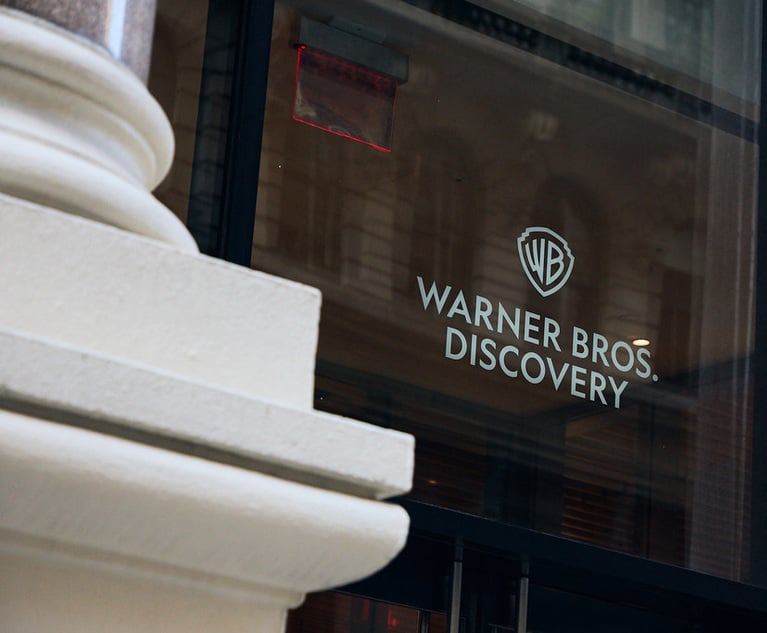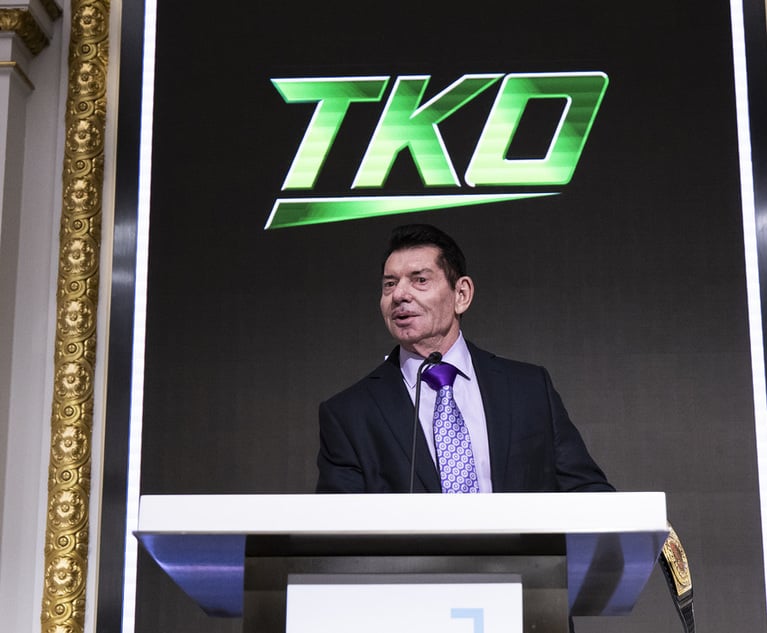Court Overrules Two Juries in Race Discrimination Suit
Following order to review by the Supreme Court, the 11th Circuit reversed a jury verdict in Ash v. Tyson a second time.
October 31, 2010 at 08:00 PM
4 minute read
An epic court battle between Tyson Foods and employee John Hithon endured for 14 years, two jury trials, three circuit court of appeals rulings and a Supreme Court opinion. In August, the 11th Circuit's fourth ruling in the case may have finally put a controversial end to the racial discrimination suit saga.
Hithon accused the company of racial discrimination in promotion decisions. In 1995, a supervisor named Thomas Hatley at the Tyson chicken processing plant in Gadsden, Ala., chose a white employee from another plant for shift manager over Hithon, an African-American who already worked at the Gadsden plant.
Tyson said the plant was performing poorly and management wanted to hire someone from outside. Hithon claimed he was qualified for the job and passed over because he was black. As part of Hithon's case, he claimed Hatley called him “boy” in a racially derogatory manner–a claim that took the case all the way to the Supreme Court, which ordered the Circuit to look more closely at context in which the supervisor used “boy.”
On Aug. 17, the 11th Circuit made its fourth Ash v. Tyson ruling. In a dense, 39-page unpublished opinion, a new and divided panel reversed a jury verdict in favor of Hithon for the second time.
“A reasonable jury could not have found that racial discrimination was the real reason” for Tyson's promotion decision, wrote the per curiam majority.
Context Counts
The first Ash v. Tyson jury awarded Hithon and another plaintiff, who has since dropped out of the case, each $250,000 in compensatory damages and $1.5 million in punitive damages. The trial judge vacated the verdict and entered judgment in favor of Tyson, saying there was no evidence of discrimination. On appeal, the 11th Circuit affirmed the trial judge's decision and concluded the word “boy,” used without modifiers, was not evidence of discrimination.
The Supreme Court vacated the Circuit opinion. The high court said the implications of “boy” depend on context. On remand, the same Circuit panel effectively made the same decision as before, saying “boy” had been used in a “conversational” and “non-racial” context.
The case was retried again anyway, in light of other circumstantial evidence the Circuit said could be pretextual evidence of discrimination. A second jury came to almost exactly the same conclusion as the first, awarding the plaintiff $300,000 in compensatory damages and $1 million in punitive damages. The same trial judge vacated the punitive award but approved everything else. But the 11th Circuit once again reversed the jury verdict.
Tyson argued it needed to hire someone not tethered to the plant's operational problems. Hatley also denied calling Hithon “boy” at all. Still, the Supreme Court took the Circuit to task for its dismissive treatment of the “boy” evidence, requiring it to look more closely at “inflection, tone of voice, local custom, and historical usage.”
But the Circuit held its ground in its August decision.
“[E]ven if somehow construed as racial, we conclude that the comments were ambiguous stray remarks not uttered in the context of the decisions at issue and are not sufficient circumstantial evidence of bias,” the majority wrote.
Jury's Job
Following the 2-1 ruling, media reports criticized the notoriously conservative appeals court for insensitivity toward southern racial tensions. From a legal policy standpoint, the 11th Circuit's choice to overrule two different juries is also unnerving, says Cozen O'Connor Member Jeffrey Braff.
“In this situation, you must prove intent, and you rarely get smoking guns. The jury has to rely on circumstantial evidence, credibility–kind of sniffing around,” he says. “The 11th Circuit took it away from the jury to make that determination.”
It's not unheard of for judges to overrule jury verdicts or push back against the Supreme Court, but the Ash panel's language was particularly harsh, according to Jeffrey Hirsch, an associate professor at University of Tennessee College of Law.
“Saying that no reasonable jury could find discrimination–that's kind of eye popping,” says Hirsch, who also writes for the Workplace Prof Blog.
Braff doesn't necessarily have a problem with the 11th Circuit's conclusion that “boy” didn't constitute race discrimination in this case. However, it wasn't the only evidence presented. Two juries also heard other testimony and put the pieces together. It was the juries' perogative to decide they didn't believe Tyson, Braff says.
“The Supreme Court said we live in the real world,” says Matthew Sarelson, senior partner at Sarelson Law Firm in Florida. “Using the word 'boy' in a certain manner clearly could be considered racial. Two juries found that it was racial.”
This content has been archived. It is available through our partners, LexisNexis® and Bloomberg Law.
To view this content, please continue to their sites.
Not a Lexis Subscriber?
Subscribe Now
Not a Bloomberg Law Subscriber?
Subscribe Now
NOT FOR REPRINT
© 2025 ALM Global, LLC, All Rights Reserved. Request academic re-use from www.copyright.com. All other uses, submit a request to [email protected]. For more information visit Asset & Logo Licensing.
You Might Like
View All


SEC Puts Beat Down on Ex-Wrestling CEO Vince McMahon for Not Reporting Settlements
3 minute readTrending Stories
- 1'It's Not Going to Be Pretty': PayPal, Capital One Face Novel Class Actions Over 'Poaching' Commissions Owed Influencers
- 211th Circuit Rejects Trump's Emergency Request as DOJ Prepares to Release Special Counsel's Final Report
- 3Supreme Court Takes Up Challenge to ACA Task Force
- 4'Tragedy of Unspeakable Proportions:' Could Edison, DWP, Face Lawsuits Over LA Wildfires?
- 5Meta Pulls Plug on DEI Programs
Who Got The Work
Michael G. Bongiorno, Andrew Scott Dulberg and Elizabeth E. Driscoll from Wilmer Cutler Pickering Hale and Dorr have stepped in to represent Symbotic Inc., an A.I.-enabled technology platform that focuses on increasing supply chain efficiency, and other defendants in a pending shareholder derivative lawsuit. The case, filed Oct. 2 in Massachusetts District Court by the Brown Law Firm on behalf of Stephen Austen, accuses certain officers and directors of misleading investors in regard to Symbotic's potential for margin growth by failing to disclose that the company was not equipped to timely deploy its systems or manage expenses through project delays. The case, assigned to U.S. District Judge Nathaniel M. Gorton, is 1:24-cv-12522, Austen v. Cohen et al.
Who Got The Work
Edmund Polubinski and Marie Killmond of Davis Polk & Wardwell have entered appearances for data platform software development company MongoDB and other defendants in a pending shareholder derivative lawsuit. The action, filed Oct. 7 in New York Southern District Court by the Brown Law Firm, accuses the company's directors and/or officers of falsely expressing confidence in the company’s restructuring of its sales incentive plan and downplaying the severity of decreases in its upfront commitments. The case is 1:24-cv-07594, Roy v. Ittycheria et al.
Who Got The Work
Amy O. Bruchs and Kurt F. Ellison of Michael Best & Friedrich have entered appearances for Epic Systems Corp. in a pending employment discrimination lawsuit. The suit was filed Sept. 7 in Wisconsin Western District Court by Levine Eisberner LLC and Siri & Glimstad on behalf of a project manager who claims that he was wrongfully terminated after applying for a religious exemption to the defendant's COVID-19 vaccine mandate. The case, assigned to U.S. Magistrate Judge Anita Marie Boor, is 3:24-cv-00630, Secker, Nathan v. Epic Systems Corporation.
Who Got The Work
David X. Sullivan, Thomas J. Finn and Gregory A. Hall from McCarter & English have entered appearances for Sunrun Installation Services in a pending civil rights lawsuit. The complaint was filed Sept. 4 in Connecticut District Court by attorney Robert M. Berke on behalf of former employee George Edward Steins, who was arrested and charged with employing an unregistered home improvement salesperson. The complaint alleges that had Sunrun informed the Connecticut Department of Consumer Protection that the plaintiff's employment had ended in 2017 and that he no longer held Sunrun's home improvement contractor license, he would not have been hit with charges, which were dismissed in May 2024. The case, assigned to U.S. District Judge Jeffrey A. Meyer, is 3:24-cv-01423, Steins v. Sunrun, Inc. et al.
Who Got The Work
Greenberg Traurig shareholder Joshua L. Raskin has entered an appearance for boohoo.com UK Ltd. in a pending patent infringement lawsuit. The suit, filed Sept. 3 in Texas Eastern District Court by Rozier Hardt McDonough on behalf of Alto Dynamics, asserts five patents related to an online shopping platform. The case, assigned to U.S. District Judge Rodney Gilstrap, is 2:24-cv-00719, Alto Dynamics, LLC v. boohoo.com UK Limited.
Featured Firms
Law Offices of Gary Martin Hays & Associates, P.C.
(470) 294-1674
Law Offices of Mark E. Salomone
(857) 444-6468
Smith & Hassler
(713) 739-1250







